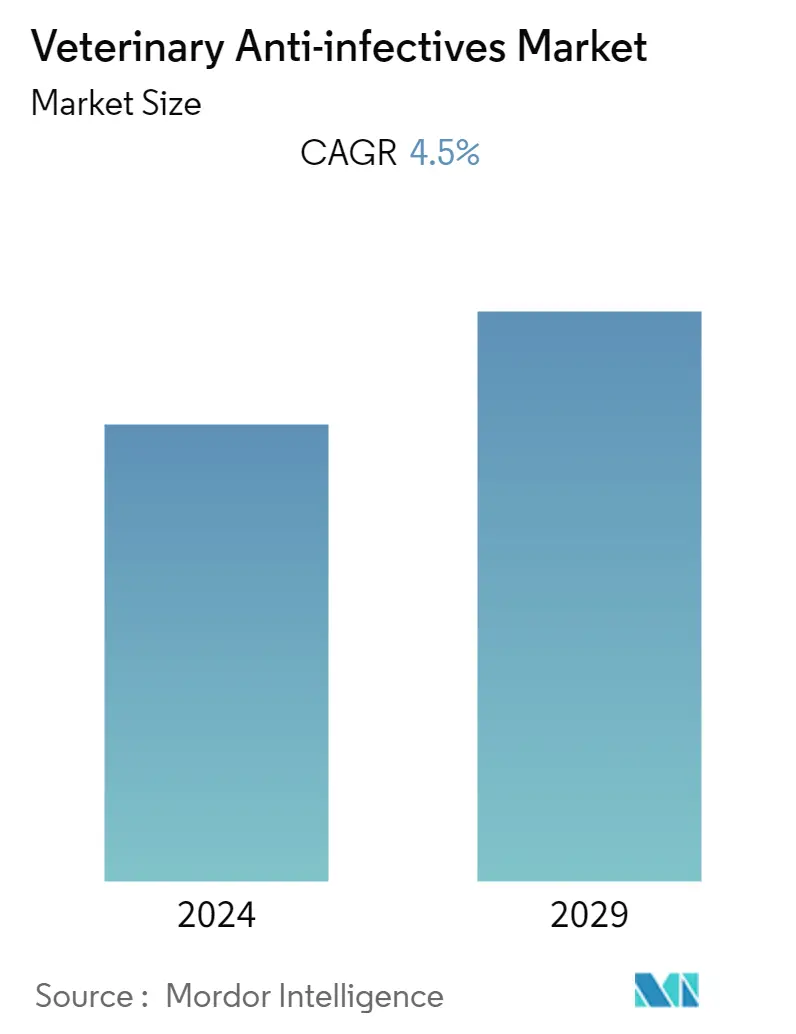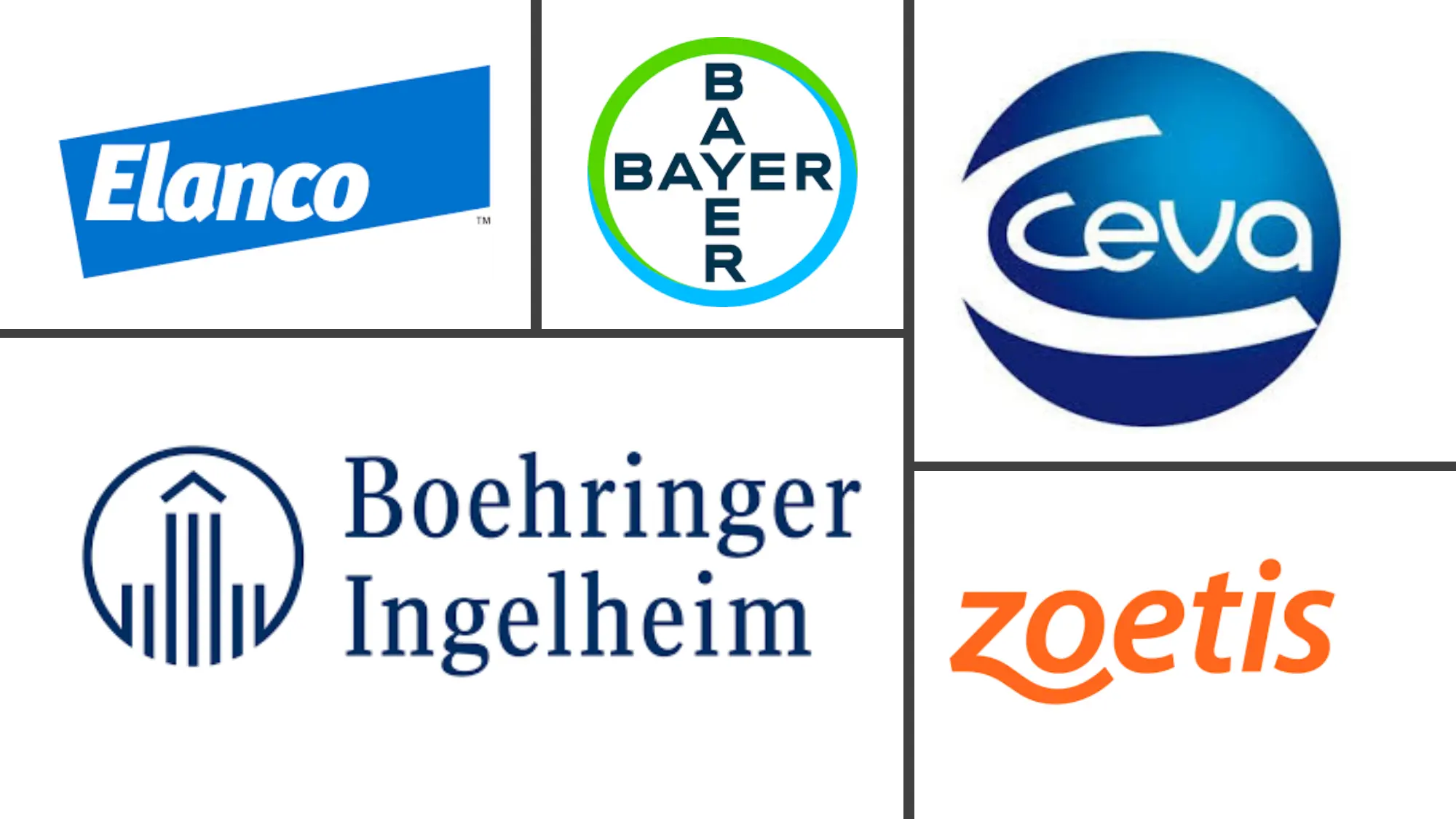Market Size of Veterinary Anti-infectives Industry

| Study Period | 2019 - 2029 |
| Base Year For Estimation | 2023 |
| Forecast Data Period | 2024 - 2029 |
| CAGR | 4.50 % |
| Fastest Growing Market | Asia Pacific |
| Largest Market | North America |
Major Players
*Disclaimer: Major Players sorted in no particular order |
Veterinary Anti Infectives Market Analysis
The prevention and treatment of deadly animal diseases are key market indicators for veterinary anti-infectives. Certain factors such as increasing zoonotic and foodborne diseases, rising pet ownership and rising R&D activities in animal healthcare. The zoonotic and foodborne diseases are naturally transmitted from animals to humans, due to the consumption of contaminated food and water, exposure to the pathogen during preparation, processing, or by direct contact with infected animals or humans. Zoonotic diseases are quite common around the world. According to the scientists of Centers for Disease Control and Prevention (CDC), over 6 out of every 10 known infectious diseases in humans are spread via animals, moreover, 3 out of every 4 new or emerging infectious diseases are spread from animals.So, it is evident that these diseases are major public health problem worldwide. Thus, increasing burden of zoonotic diseases is expected to impact the growth of the market.
Veterinary Anti Infectives Industry Segmentation
As per the scope of the report, Anti-infectives include a wide range of animal health products which prevent infectious agents or organisms from spreading. These include Antibacterial, Antivirals, Antifungals, etc.
| By Animal Type | |
| Cattle | |
| Poultry | |
| Cats | |
| Dogs | |
| Other Animals |
| By Product Type | |
| Antibacterial | |
| Antivirals | |
| Antifungals | |
| Others |
| By Mode of Administration | |
| Oral | |
| Topical | |
| Others |
| Geography | ||||||||
| ||||||||
| ||||||||
| ||||||||
| ||||||||
|
Veterinary Anti-infectives Market Size Summary
The veterinary anti-infectives market is driven by the need to prevent and treat animal diseases, with significant influence from the increasing prevalence of zoonotic and foodborne diseases. These diseases, which can be transmitted from animals to humans, pose a substantial public health challenge globally. The rising pet ownership and heightened research and development activities in animal healthcare further contribute to market growth. The market is segmented by animal type, including cattle, poultry, cats, dogs, and others, with the cattle sub-segment experiencing notable growth due to the large global cattle population and the economic importance of cattle farming in countries like China and Mexico. The approval of new products, such as Bimeda's OxyMed LA for treating bacterial enteritis in swine and cattle, is expected to positively impact the market.
Regionally, North America plays a significant role in the veterinary anti-infectives market, supported by advanced animal healthcare programs and increased awareness of animal health. The poultry and meat industries are major components of the United States agriculture sector, driving demand for effective animal disease treatments. The presence of global players such as Bayer AG, Boehringer Ingelheim GmbH, and Zoetis Inc. underscores the competitive landscape of the market. The ongoing rise in animal disease burden necessitates swift and effective treatment options, which is anticipated to further propel market growth in the coming years.
Veterinary Anti-infectives Market Size - Table of Contents
-
1. MARKET DYNAMICS
-
1.1 Market Overview
-
1.2 Market Drivers
-
1.2.1 Increasing Zoonotic and Foodborne Diseases
-
1.2.2 Rising Pet Ownership
-
1.2.3 Rising R&D Activities in Animal Healthcare
-
-
1.3 Market Restraints
-
1.3.1 Use of Counterfeit Medicines
-
1.3.2 Increasing Cost of Veterinary Services
-
-
1.4 Porter's Five Forces Analysis
-
1.4.1 Threat of New Entrants
-
1.4.2 Bargaining Power of Buyers/Consumers
-
1.4.3 Bargaining Power of Suppliers
-
1.4.4 Threat of Substitute Products
-
1.4.5 Intensity of Competitive Rivalry
-
-
-
2. MARKET SEGMENTATION
-
2.1 By Animal Type
-
2.1.1 Cattle
-
2.1.2 Poultry
-
2.1.3 Cats
-
2.1.4 Dogs
-
2.1.5 Other Animals
-
-
2.2 By Product Type
-
2.2.1 Antibacterial
-
2.2.2 Antivirals
-
2.2.3 Antifungals
-
2.2.4 Others
-
-
2.3 By Mode of Administration
-
2.3.1 Oral
-
2.3.2 Topical
-
2.3.3 Others
-
-
2.4 Geography
-
2.4.1 North America
-
2.4.1.1 United States
-
2.4.1.2 Canada
-
2.4.1.3 Mexico
-
-
2.4.2 Europe
-
2.4.2.1 France
-
2.4.2.2 Germany
-
2.4.2.3 United Kingdom
-
2.4.2.4 Italy
-
2.4.2.5 Spain
-
2.4.2.6 Rest of Europe
-
-
2.4.3 Asia-Pacific
-
2.4.3.1 China
-
2.4.3.2 Japan
-
2.4.3.3 India
-
2.4.3.4 Australia
-
2.4.3.5 South Korea
-
2.4.3.6 Rest of Asia-Pacific
-
-
2.4.4 Middle-East and Africa
-
2.4.4.1 GCC
-
2.4.4.2 South Africa
-
2.4.4.3 Rest of Middle-East and Africa
-
-
2.4.5 South America
-
2.4.5.1 Brazil
-
2.4.5.2 Argentina
-
2.4.5.3 Rest of South America
-
-
-
Veterinary Anti-infectives Market Size FAQs
What is the current Veterinary Anti-infectives Market size?
The Veterinary Anti-infectives Market is projected to register a CAGR of 4.5% during the forecast period (2024-2029)
Who are the key players in Veterinary Anti-infectives Market?
Bayer AG, Boehringer Ingelheim GmbH, Ceva Santé Animale, Elanco and Zoetis Inc. are the major companies operating in the Veterinary Anti-infectives Market.

